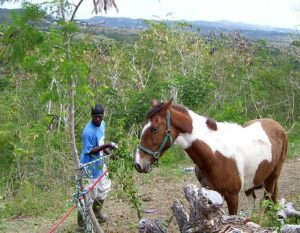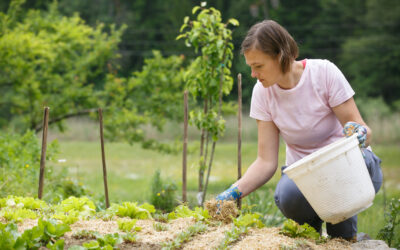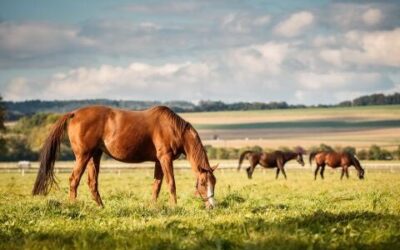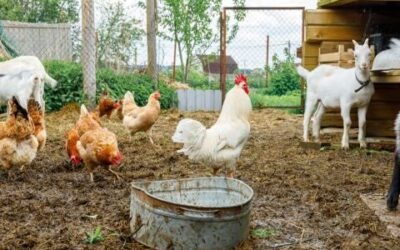Bagged Feed May Herald A New Approach for Island Horses
Dr. Bethany Bradford is talking with me on her cell phone because there are still no land lines in her office where she works as the Director of Veterinary Services at the Virgin Islands Department of Agriculture. There is power; the building ran on a generator until January, but no traffic lights are working, and the infrastructure, left in ruins, will require years of rebuilding. It has been six months since back-to-back Category 5 hurricanes devastated the island she calls home. “The storms were awful,” she confirms, as if it goes without saying. “There was no communication, a curfew, no electricity. People’s homes were either wrecked or damaged. We’re still trying to come back from that. We have a long way to go.”

Staff member, Trevor Aldridge, working a herd of Senepol cattle, a breed developed in St. Croix, USVI
Bradford and her three staff members work and live on St. Croix, the largest of the three islands that make up the Virgin Islands, which also includes St. Thomas and St. John. The three islands, her jurisdiction, have a population of 103,000. As Director of Veterinary Services, her job involves, in part, disease control, influenza testing and surveillance, and spraying for ticks – a pervasive pest on the islands. She and her team perform sheep and cattle vet services such as castration, deworming, tagging of livestock and microchipping of horses, a requirement. She is also in charge of regulating the import and export of animals, mostly involving imports of horses for the racetracks when they are running. Here, goats and sheep, about 4,000 of each, are raised solely for meat. There are no dairy goats (though Bradford keeps some at her home) and the sheep grow hair, not wool. There are about 1,000 pigs and 1,000 beef cattle (notably Senepol, a breed developed on St. Croix that has been exported all over world), plus poultry and birds for game fighting, a legal sport on the islands.
The human toll of the hurricanes was staggering, no small part of which were losses of livestock and horses. There are approximately 1,200 horses on US-VI. Two-thirds are on St. Croix, including those owned by farmers and thoroughbreds that work on one of two racetracks, on St. Croix and St. Thomas. The biggest health challenges concerned feet and hooves – many animals stood in water for days before people could get to them – and skin, from exposure to intense sun where there was no shade. Many horses were lost, and many thoroughbreds put down. Others, with proper treatment, pulled through.
What Is That Stuff?
Until the hurricanes, there had been good weather: plenty of grass and rain. After the storms hit, the food supply was severely compromised. When shipments of feed eventually arrived at Bradford’s office in the wake of the chaos, it was a welcome source of relief. Donations were made from several different organizations and arrived in 40-foot containers. Some were filled with feed for livestock, some for horses, and some, particularly welcome, an assortment for all species including dog food and pig food. It was distributed to registered farmers and owners, and whatever was left, would circulate again.
For horses, there were alfalfa cubes, chopped timothy, and bagged feed from Lucerne Farms. “I’d never seen hay bagged,” said Bradford. “The farmers said, ‘What is this stuff?’ They’d never heard of it either.” The Lucerne Farms bags contained a high-quality, high-fiber forage in a variety of blends, dried to lock in nutrients and eliminates spore, and chopped and compressed into the convenient bales that intrigued Bradford. She joked that maybe she had “been here too long,” perhaps the suspicion of a transplant from the States. But in fact, her unfamiliarity with bagged feed had everything to do with the culture of the islands where good weather is plentiful and fresh grass is on resident horses’ menu year-round.
From Maine to St. Croix
Dr. Bradford is a Yarmouth, Maine native, part of the reason she was drawn to the Lucerne Farms forage with the Maine address on its bags. After she graduated from college with an Animal Science degree, she spent the summer pulling in seasonal waitressing money from a summer in Bar Harbor and working at a goat farm. When the tourists cleared out, she developed a new plan. She crewed a boat all the way down the coast, and from there got the rest of the way to St Croix. “I loved it immediately,” she said. While the friends she came with ultimately left the island, she stayed, got job at Department of Agriculture as a Veterinary Technician. She went to veterinary school and took a government job in St. Thomas. Ten years later, when the job as Director of Veterinary Services opened up in St. Croix., she was hired.
Many think of the Caribbean islands as an expanse of sandy beaches. St. Croix’s inland, however, consists of spacious, rolling hills. Horses graze there, dependent on the local grasses, always tied to keep them from straying, relying on owners to move them from place to place. Bradford said visitors who don’t understand the practice of tying out can be unnerved by it. “People don’t have yards, they can’t board a horse – there is land sitting there, and people just use it.” She said it works out fine, as long as the animals are taken care of, given plenty of food and water, and no one complains.
In fact, horses and livestock live on grass. Just one farm harvests hay, and grain is relegated to the racehorses. In a culture of year-round warm weather, a mindset to feed green and feed right away – no storage – has taken hold. Grasses are diverse, drought tolerant, and reasonably nutritious, and grasses like guinea grass must be cut and fed quickly to maintain its protein content anyway. Bagged hay, if relied upon more, could be a life-saver in difficult weather, particularly dry seasons, and the local feed store is counting on it.
Bagged Hay for a Dry Season
Dry season generally occurs from January to March, and while it arrives every year, Bradford said for farmers it seems to always come as a surprise. Some years are worse than others. In 2015, a severe drought was devastating for farmers, and St. Croix was declared a disaster area. It was the worst drought anyone had seen, Bradford said. “Many people here live hand to mouth, and when they run out of grasses, there’s nothing to cut.” That year, they received some hay from Puerto Rico, but it was not much, and it was only 5% protein. Many animals were lost for want of pasture.
This year, St. Croix’s local feed store is working with Florida dealers to stock bagged forage, anticipating the need during the dry season. Bradford for one, is a convert. When it comes to bagged feed, there’s no waste, it’s easy to feed, and it stays dry in storage. “That’s huge,” she said, “because here you never know. Everything comes in on the boat, and you don’t know if the boat is coming. If you don’t prepare, you don’t have feed.” She’s doing her best to challenge thinking when it comes to feeding. Because protein is an issue during dry season, she urges farmers to read labels for content rather than price, so each mouthful has more value. And, of any excess bagged feed from the relief shipment, she told farmers, “If you don’t need it now, put it somewhere, out of the rain and out of the sun.” As a Maine native, she’s the perfect agent for planning for what’s around the corner. “Where I come from,” she said, “you die if you’re not ready for winter.”









